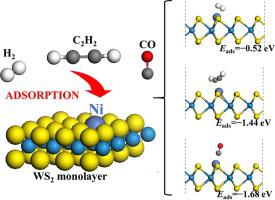Applied Surface Science ( IF 6.3 ) Pub Date : 2021-12-07 , DOI: 10.1016/j.apsusc.2021.152141 Dachang Chen 1 , Yi Li 2 , Song Xiao 2 , Caixia Yang 1 , Jin Zhou 1 , Beibei Xiao 3

|
Insulation defects and equipment failure often exist in power transformer, and insulating oil in transformer will experience decomposition with a series reaction. By detecting the dissolved gases in insulating oil, the operation status of transformer can be evaluated. In this study, the adsorption and gas sensing of several kinds of typical dissolved gas molecule (H2, C2H2, and CO) on pristine and single Ni atom doped WS2 monolayer (Ni-WS2) was theoretically investigated based on first-principles density functional theory. To discuss the adsorption behavior, the structures, adsorption energies, and electron transfers were calculated and compared. As to the electronic properties and chemical interactions between gas molecule and Ni-WS2, the band structures, density of states (DOS), and work functions were studied. The results show that, after the doping of Ni, the adsorption energies of H2, C2H2 and CO on WS2 monolayer increase dramatically, from −0.06 eV to −0.52 eV, −0.23 eV to −1.44 eV, and −0.15 eV to −1.68 eV, respectively. On Ni-WS2, H2 and C2H2 lose electrons while CO shows little electron transfer. Only the adsorption of C2H2 obviously reduces the band gap of Ni-WS2. For all three kinds of gas adsorption, hybridization of states between Ni 3d and atomic orbitals in molecule can be observed in DOS, indicating considerable chemical interactions. In addition, the adsorption of CO increases the work function of Ni-WS2 from 5.56 eV to 5.80 eV. Based on the change of different physical and chemical properties, the Ni-WS2 as sensing material in different gas sensors was evaluated and the desorption time was compared in order to shed light on the experimental realization to detect dissolved gas molecule in insulating oil with high sensitivity and selectivity.
中文翻译:

单个 Ni 原子掺杂的 WS2 单层作为变压器油中溶解气体的传感基质:第一性原理研究
电力变压器经常存在绝缘缺陷和设备故障,变压器中的绝缘油会发生分解并发生串联反应。通过检测绝缘油中的溶解气体,可以评估变压器的运行状态。在本研究中,几种典型的溶解气体分子(H 2、C 2 H 2和CO)在原始和单Ni原子掺杂WS 2单层(Ni-WS 2) 基于第一性原理密度泛函理论进行了理论研究。为了讨论吸附行为,计算并比较了结构、吸附能和电子转移。对于气体分子与Ni-WS 2之间的电子性质和化学相互作用,研究了能带结构、态密度(DOS)和功函数。结果表明,在掺杂Ni后,WS 2单层上H 2、C 2 H 2和CO的吸附能急剧增加,从-0.06 eV到-0.52 eV,-0.23 eV到-1.44 eV,和-分别为 0.15 eV 至 -1.68 eV。在 Ni-WS 2、H 2和 C 2 H 2 上失去电子而 CO 几乎没有电子转移。只有C 2 H 2的吸附才能明显降低Ni-WS 2的带隙。对于所有三种气体吸附,在 DOS 中都可以观察到 Ni 3d 和分子中原子轨道之间的状态杂化,表明存在相当大的化学相互作用。此外,CO 的吸附使 Ni-WS 2的功函数从 5.56 eV 增加到 5.80 eV。根据不同理化性质的变化,Ni-WS 2 评估了不同气体传感器中的传感材料,并比较了解吸时间,以阐明实验实现以高灵敏度和选择性检测绝缘油中溶解的气体分子。





















































 京公网安备 11010802027423号
京公网安备 11010802027423号